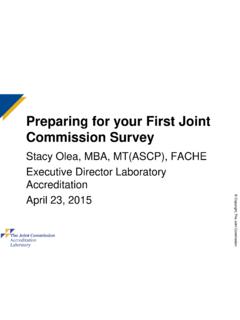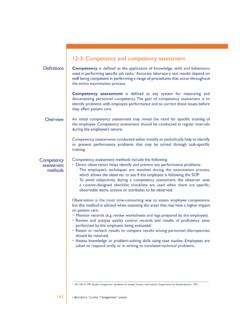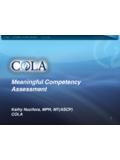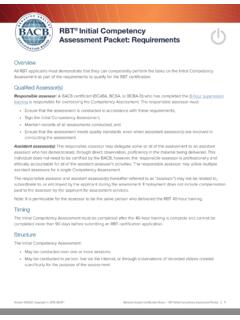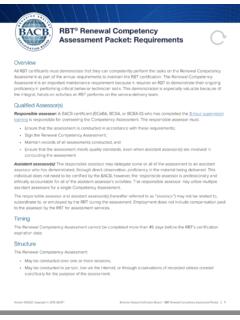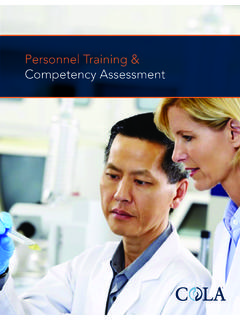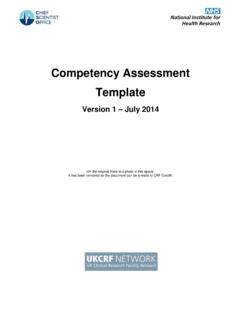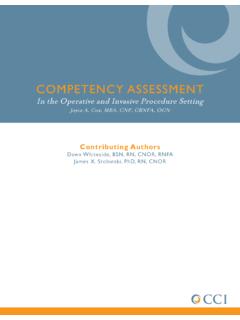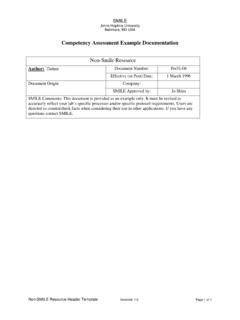Transcription of Competency Assessment How, who, what, when and why
1 Competency Assessment Who, What, When, Why and HowDonna D CastelloneMS, MASCP, MT(ASCP)SHQuality ManagerNew York Presbyterian/Columbia Medical York Presbyterian-Columbia Medical Objectives Define Competency Explain difference between training and Competency List the elements required for Competency Assessment Discuss who can perform Competency assessmentsCompetency See one Do one Teach one!Most Commonly Cited Deficiencies 2016 College of American Pathologists. All rights Management System QSE: Personnel Obtaining and retaining an adequate number of qualified, well trained, and competent laboratory staff to perform and manage the activities of the laboratory. GP26-A4 Quality Management System The effectiveness of training and competence directly affects the laboratory s ability to meet it s quality goals and objectives. Competence ongoing Assessment is required to verify job performance Must be documented and different from trainingWhy?Prevent: Errors Non-Standard work Complacency Not following SOP short cuts developed by personnelCaused by: Loss of familiarity of processes or SOP s Rotation through other labs Working in only one section of the lab Who Requires Competency Assessment ?
2 Everyone! CMS CAP State regulations AABB FDA FACT Joint CommissionCLIA Considered a minimum set of guidelines for quality All clinical labs in the USA must meet these guidelines in order to receive Medicare and Medicaid re-imbursement Most labs try to take beyond and have a Quality Management SystemDefine Competency The ability of personnel to apply their skill, knowledge and experience to perform their laboratory duties correctly. Assessment Is used to ensure that the laboratory personnel are fulfilling their duties as by federal for Medicare and Medicaid ServicesProficiency Testing vs. Performance Appraisal Proficiency Testing (PT) Assesses the laboratory s ability to perform accurate and reliable testing by the testing of unknown samples sent to the lab by a CMS approved PT program. Performance appraisal evaluates general job/position performance and is more subjective. May include Competency Competency Assessment ensures conformance to standard procedures and is objective and binary ( competence observed or not).
3 Why? One thing worse than training employees and losing is not training them and keeping them. -Ed MetcalfWhat Are the Requirements? = The Competency of each person to perform his/her assigned duties is assessed. Evidence of Compliance: Records of Competency Assessment for new and existing employees reflecting the specific skills assessed, the method of evaluation. A laboratory must evaluate and document the Competency of all testing personnel for each test system. A TEST SYSTEM is the process that includes pre-analytic, analytic, and post-analytic steps used to produce a test result or set of Documentation of these elements, including observation of test performance, results reporting, instrument maintenance, review of worksheets, recording QC, performance of PT, and demonstration of taking appropriate corrective actions are examples of daily activities that can be used to demonstrate Competency . If elements of Competency are assessed by routine supervisory review, the Competency procedure must outline how this routine review is used to evaluate Competency .
4 Competency Assessment by routine supervisory review may be documented by a checklist. For nonwaived test systems, six elements must be assessed annually. For waived test systems, the laboratory may select which elements to tests Waived tests require minimal technical Competency and they yield low risk in the event of an erroneous result. Any individual can perform a waived test in a physician office or their home and no educational or professional training is required. If the test is performed in a physician s office, the office must apply for a CLIA certificate and the facility that performs the test must comply with all the manufacturer recommendations. CLIA doesn t demand any other regulations for waived tests. Certificate of Waiver (CoW) Enroll in the CLIA program Pay biennial certificate fees Only perform tests categorized as waived Not subject to routine inspections Must follow manufacturer s instructions Issues with waived testing In the waived test environment, the methodology or the instrument used is very good.
5 It's in the preanalyticand postanalyticphases for example, human errors that occur while the test sample is being gathered, or after the test has been run that industry-wide, no matter what the test classification is, there are issues involved with quality. Most laboratories in the United States now are using waived testing devices that have pre-analytic and post-analytic problems These sites are generating problem data that are being used in the diagnosis and treatment of my laboratory only performs waived testing, do I need written policies for assessing personnel Competency ? CLIA does not require policies for assessing personnel Competency for waived testing. Even though CLIA has no specific requirements for personnel performing waived testing, you need to ensure that patient testing results are correct to assist in making an accurate patient diagnosis. You will need to ensure that testing personnel are following all manufacturers instructions. Testing personnel who are properly trained and performing the test correctly will aid the physician/provider in making an accurate patient diagnosis.
6 If your laboratory is accredited, you may need to consult your accrediting organization s waived tests Non-waived tests are defined as either moderate or high complexity. Unique educational and professional experience are required to perform non-waived tests. CLIA and the Food and Drug Administration (FDA) determines the complexity of the test, using specific criteria. Healthcare facilities that perform non-waived tests must obtain a CLIA certificate and abide by CLIA regulations. In addition, the facility must be inspected periodically and provide proof that they comply with the CLIA quality requirements. All Laboratory Developed Tests (LDT), and non-FDA approved tests are classified as high complexity tests and CLIA requirements are more rigorous for these kinds of tests. What happens when you adjust how a test is performed. Devices used outside of the manufacturer s requirements are considered to be test modification/off label use. This is not a new CLIA regulation!
7 Test modification/off label use Any change to a test system/device or manufacturer s instructions or intended usethat affects the test s performance specifications for accuracy, precision, sensitivity or specificity. Modified tests become high complexitytests under CLIA Competency RequirementsThe following 6 elements are the minimal requirements observation (handling, preparation, processing, testing) the recording and reporting of of intermediate test results or worksheets, QC, records, PT results, and PM records4. Direct observation of performance of instrument maintenance and function checks5. Assessment of problem solving skills, case studies, quizes6. Assessment of test performance using previously tested specimens, blind specimens and external proficiency samplesNew York State: (in case you perform testing from NYS)7. NYS has added a 7th. Requirement of observation of compliance with safety protocols8. Assessment of Competency of any delegated supervisory functions recently added by NYS Training vs.
8 CompetencyTraining Occurs before patient testing begins Usually once unless employee fails successful demonstration of skill to trainer and retrainingrequired Does not require use of six Competency Assessment elementsCompetency Occurs after independent patient testing begins Does require use of six Competency Assessment elements for non-waived testing17 Training ChecklistTrainingTraineeTrainerUnderstan ds the intended use of the of principle of procedureSpecimen requirements: collection and storagePPE requirementsReagent preparationPull pending log and worksheetAdditional materials requiredReview of the SOPQ uality control samplesPreparation of blood smearStorage and stability of smearsDrying the smearFixing the smearsStaining the smearsUsing the microscopeIdentifying the granulesScoring the samplesReference rangeRecording of resultsInterpretation of ResultsReporting results in CernerTRAINING Leukocyte Alkaline Phosphatase (LAP)NAME:_____ DATE:_____TRAINER:_____Training completed:_____ by _____I understand the procedure and feel confident to perform the York-Presbyterian Hospital / Columbia University Medical Center DEPARTMENT OF CLINICAL LABORATORIESANNUAL Competency Assessment CHECKLISTE mployee Name: Test EmployeeDept: LaboratoryYear: Policy: HR-9iCompetency Assessment is used to ensure that the laboratory personnel are fulfilling their duties as required by the department and federal of Assessment :1) direct observation;2) observation for compliance with safety protocols;3) periodic review of work product for compliance with standard operating procedures and applicable workload limits;4) monitoring the recording and reporting of test results;5) direct observation of performance of instrument maintenance and function checks;6) Assessment of test performance through testing of previously analyzed specimens, internal blind or external proficiencytesting samples.
9 7) Assessment of problem solving ) Assessment of delegated functionsEvaluate the Competency of staff for all tasks for which he/she is responsible. Indicate evaluation for each task as: YES (competent) or NO (not competent). Areas that the employee is not responsible will be marked NA (not applicable). If the staff is not competent, a corrective or remedial action should be initiated and documented and filed with this Analyzer1) Direct Observation2) Safety Compliance3) Compliance w/ SOP4) Review test results5) Instrument Maintenance6) Unknown/PT Samples7) Problem Solving8) Delegated functionsSpecimen requirements.[ X ] YES [ ] NO[ X ] YES [ ] NO[ X ] YES [ ] NO[ X ] YES [ ] NA If YES, date of event: Accession #: [ X ] YES [ ] NA[ ] YES [ ] NA If YES, date of event _____ score: _____[ X ] YES [ ] NO[ ] Check If Task Is Not ApplicableSample Handling and Stability[ X ] YES [ ] NO[ X ] YES [ ] NO[ X ] YES [ ] NA[ X ] YES [ ] NOAssessedProcessing[ X ] YES [ ] NO[ X ] YES [ ] NO[ X ] YES [ ] NA[ X ] YES [ ] NOMeasurement methodology[ X ] YES [ ] NO[ X ] YES [ ] NO[ X ] YES [ ] NA[ X ] YES [ ] NOBy: Quality Control[ X ] YES [ ] NO[ X ] YES [ ] NO[ X ] YES [ ] NA[ X ] YES [ ] NOReporting Results[ X ] YES [ ] NO[ X ] YES [ ] NO[ X ] YES [ ] NA[ X ] YES [ ] NODate.
10 Reagent Handling and Storage[ X ] YES [ ] NO[ X ] YES [ ] NO[ X ] YES [ ] NA[ X ] YES [ ] NOMaintenance[ X ] YES [ ] NO[ X ] YES [ ] NO[ X ] YES [ ] NA[ X ] YES [ ] NODelegated QC Review[ X ] YES [ ] NADelegated Staff Training[ X ] YES [ ] NADelegated Regulatory Tasks[ X ] YES [ ] NADelegated Scheduling[ X ] YES [ ] NARadiometer ABL 800 Blood Gas Analyzer1) Direct Observation2) Safety Compliance3) Compliance w/ SOP4) Review test results5) Instrument Maintenance6) Unknown/PT Samples7) Problem Solving8) Delegated functionsSpecimen requirements.[ ] YES [ ] NO[ ] YES [ ] NO[ ] YES [ ] NO[ ] YES [ X ] NA If YES, date of event: _____ Accession #: _____[ ] YES [ ] NA[ ] YES [ ] NA If YES, date of event _____ score: _____[ ] YES [ ] NO[ ] Check If Task Is Not ApplicableSample Handling and Stability[ ] YES [ ] NO[ ] YES [ ] NO[ ] YES [ ] NA[ ] YES [ ] NOAssessedProcessing[ ] YES [ ] NO[ ] YES [ ] NO[ ] YES [ ] NA[ ] YES [ ] NOMeasurement methodology[ ] YES [ ] NO[ ] YES [ ] NO[ ] YES [ ] NA[ ] YES [ ] NOBy: _____Quality Control[ ] YES [ ] NO[ ] YES [ ] NO[ ] YES [ ] NA[ ] YES [ ] NOReporting Results[ ] YES [ ] NO[ ] YES [ ] NO[ ] YES [ ] NA[ ] YES [ ] NODate.


